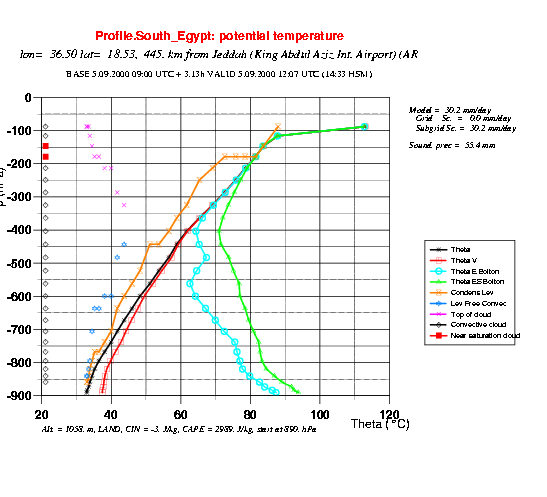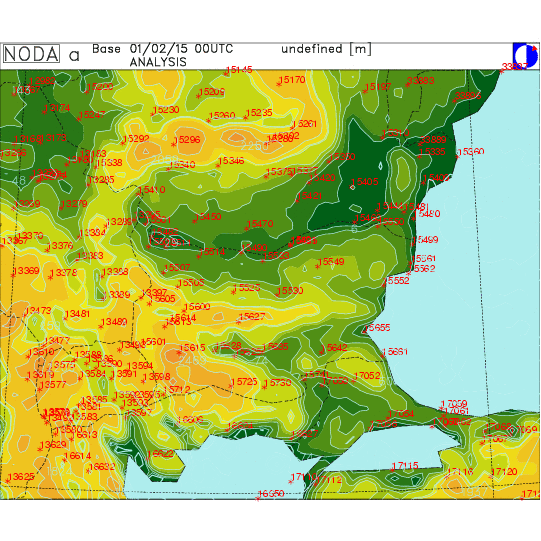
1. Main events
The GMAP team welcomed 32 ALADIN / ALATNET visitors along these two quarters. They worked in Toulouse for 2 weeks to 6 months, often splitted into several stays, or topics, or fundings. The developments related to the ALATNET research program are presented in the 2nd ALATNET Newsletter.
Once again a large part of the effort was devoted to code maintenance : creation of cycles AL14 and CY23T1, additional code cleaning, analysis of the problems brought by the suppression of the shared-memory configuration (imposed by the IFS team) ... and renewal of the ALADIN web site. Many thanks to Radmila Brozkova, Ilian Gospodinov, Andras Horanyi, Stjepan Ivatek-Sahdan, Metod Kozelj, Richard Mladek, Gabor Radnoti, Roger Randriamampianina, Oldrich Spaniel, Malgorzata Szczech and Yong Wang for their help !
From January 1st, 2001, GMAP is reorganizing, moving from 3 teams :
to 4 thematic teams :
Each team is now concerned by both ARPEGE and ALADIN. New permanent scientists are expected for 2001. Most ALADIN contact points don't change, with as usual exceptions : Jean-Marc Audoin is now responsible for the topics "workstation" and "coupling".
Beside the two new ALATNET students, Gianpaolo Balsamo and Cornel Soci, four visitors are currently at GMAP for long stays : Judith Padilla-Barbosa (ALGO), Olivier Pédoussaut (COOPE), Nadia Fourrié and Zhiqan Liu (OBS).
2. Dynamics
Most of the work in this domain was devoted to ALATNET topics (non-hydrostatism, relaxation of the thin-layer hypothesis) and the completion of the PhD thesis of Ilian Gospodinov.
The instabilities which appeared in the autumn parallel suites also required an improvement of the spectral brake, which now acts at the critical layer and above (Ryad El Khatib).
3. Physics
The design and refinements of the CYCORA-bis package was the main non-ALATNET task of the last months. This modset was tested in parallel suites for 5 months from September, with changing vertical and horizontal resolutions in ARPEGE and ALADIN. Thanks to the efforts of Martin Bellus, Jean-François Geleyn and Jean-Marcel Piriou in Toulouse and the distant help from Doina Banciu, the following modifications were introduced in operations on January 24th, 2001 :
4. Diag-Pack / Optimal Interpolation analysis
Gabor Radnoti thoroughly analysed the feasibility of an analysis of visibility, starting from the system used at UKMO, and wrote a detailed working plan.
Lora Gaytandjieva, Elisabeth Gérard and Françoise Taillefer significantly improved the analysis of the snow water content, from synoptic observations of snow height. The statistical model was improved, adding a vertical component to the correlation function :
m (Dr , Dln(p))= exp ( - Dr2 / 2D2 ) ´ exp ( - Dln(p)2 / 2P2 )
and tuning the horizontal characteristic length D (to take into account the sparse observations) and the vertical characteristic parameter P (to improve the consistency between snow cover and height). The geographical selection of observations was also corrected, and the observation operator improved. The first tests with a full set of observations showed a real improvement. This scheme was first to be implemented in the ARPEGE assimilation suite, to improve the localisation of snow-covered areas at initial time. It might as well be used for diagnostic purpose. Anyway, this is still an open research field.
The feasibility study for an operational implementation of Diag-Pack at Météo-France started on July. The first steps were the definition of the observation set (between 1700 and 2000 stations over France) and of the reference forecast, the choice of visualisation tools, and the tuning of surface analysis (T2m, Hu2m, V10m, ps). The tests situations were selected, and are now controlled, by forecasters. Upperair analysis is not considered up to now, taking into account its higher cost, the necessary retuning of statistics to ensure continuity near the surface, and the very irregular distribution of the available (aircraft) observations, both in space and time. [alias : RETIC-J98A]
Olivier Latinne spent a few weeks in July validating an assimilation suite for ALADIN / Belgium (based on CANARI).
5. Full-Pos / Changes of geometry
Vanda Sousa Da Costa and Ryad El Khatib tested the latest developments in Full-Pos.
a. 4-points versus 12-points interpolation
A thorough comparison between quadratic, monotonic-quadratic (new ! preventing overshooting) and bilinear interpolations was performed, considering only surface and boundary-layer fields. The experiments showed a deterioration along coasts with bilinear interpolations.
b. New post-processing of boundary layer fields
This new method, where boundary-layer fields are recomputed on the target grid using interpolated surface and upperair variables and the target surface constants, was compared with the previous one using 2 months of operational ARPEGE and ALADIN / FRANCE forecasts (August and November 2000). Results are quite encouraging, especially for 2m-temperature.
c. Changes for surface fields
Up to now the interception water content (water on the leaves, prognostic variable) and the resistance to evapo-transpiration (diagnostic variable) were set to constant values (0. and 1. respectively, as when starting climatic runs) in Full-Pos. This choice was motivated by the high spatial variability of these fields and the lack of controls against overshooting in Full-Pos when ISBA was implemented. This variables may now be interpolated as the other surface fields, with minima, maxima on land consistent with the physical parameterizations (0.-1., 0.- a veg LAI resp.). The impact on superficial temperature and soil moisture along short-range forecast may be significant (depending on precipitations of course).
The roughness lengths over sea are now interpolated (rather than set to their constant climatological value).
d. New diagnostics
The structure of the code was first changed to make the introduction of new fields easier, with a first application to :
* water-vapour column
* improved wind-gusts formulation
* various formulations of MOCON
* duration of precipitations
* min./max. of relative humidity at 2m
* heights of iso T=0 K and iso q'w=0 K
* ...
And the autumn parallel suites enabled to diagnose and correct a bug in E927, active when a pole of the ARPEGE grid is in the target ALADIN domain.
for more details contact : Ryad.ElKhatib++at++meteo.fr
6. Configuration 923 / Surface description
a. New databases
Igor Kos, Rashyd Zaaboul and Eric Bazile, with some help from François Bouyssel and Dominique Giard, contributed to a complete renewal of the climatological values of surface variables over land. The new global databases have a resolution of 1° (instead of 1.5°) and various origins :
The initial data were carefully controlled and compared, and transformed to a suitable format (regular latitude ´ longitude grid, handling of missing values, conversion of soil moisture fields). The new fields of moisture and snow look more realistic, when considering the annual cycle and the geographical distribution.
Two 3-weeks long assimilation experiments were launched for a winter and a summer period, to asses the impact of the new soil moisture : operational assimilation versus fixed to the new climatological value. They gave useful informtions on :
Longer assimilation experiments were performed afterwads on January-February 2000, showing a slight improvement in the description of soil moisture and snow cover when using the new climatology for all surface fields.
These studies led to introduce some more limits on climatological surface fields :
An analysis of the correlations between the snow water content, the surface temperature and its mean value, using 2 months of ARPEGE data, was also undertaken. It aimed at improving the interpolation of snow fields, in configurations 701, 927 or 923, defining a correction with altitude. But results were quite puzzling, showing the persistence of snow up to 10°C.
The huge work related to the new land-cover map is described in the ALATNET section.
b. Evolution of the code
Apart from the above-mentioned modifications for climatological surface variables, several developments were undertaken (Dominique Giard) :
7. Support
An updated documentation for the 1d version of ARPEGE /ALADIN (or Single Column Model) will soon be available.
for more details contact : Jean-Marcel.Piriou++at++meteo.fr


 |
Home |